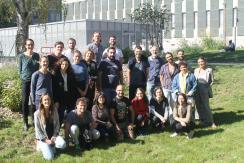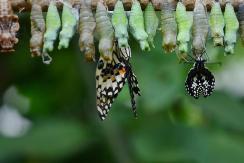COEVOL Multi-Scale Coevolution
Living systems are highly integrated, with a multitude of levels of organization, from molecular and intra-cellular scales to ecosystems. Complex organisms are themselves consortia of macro- and micro-organisms, which work together with their host to build the individual. Yet, each of these organisms can function and evolve in the short term according to its own logic, possibly in conflict with other higher or lower levels, or with other time scales. The once common idea among evolutionists that natural selection results in organisms perfectly adapted to their environment is now severely undermined. Not only because, as the Red Queen explains to Alice, one has to run relentlessly to keep its place in a changing environment, or because past evolutionary history and chance constrain the possibilities of present adaptation, but also because different levels of selection have interests that are generally difficult to reconcile.
Multi-scale coevolution resets classical questions in evolutionary biology
One example, of particular interest is the question of the source of heritable variations. The phenotype of organisms in a population is influenced not only by variations in their nuclear and mitochondrial genomes, the dynamics of which is the object of population genetics, but also more and more patently by the consortium of microbes and genetic elements that constitute its microbiome and virome. The hologenome designates this complex assembly of genetic materials, which obey different rules of transmission and different evolutionary strategies. The ability of symbionts to manipulate host phenotypes or to interfere with each other influences the evolutionary dynamics of all players in ways that are yet poorly understood. In addition, new questions arise, such as the importance of co-adaptation in these systems and their consequences in maintaining cohesive biological systems.
- Symbiosis: a response to and a source of divergent selection
Using a variety of approaches combining experimental evolution, genomic, functional, phenotypic and behavioral data, we aim to test whether symbiosis facilitates diversification and to characterize the underlying microevolutionary processes.
- Ecological networks of horizontal gene transfer
We develop original methods to detect gene transfer and we investigate the factors that influence the routes of gene transfers among microbes but also among insects.
- The interplay between symbiosis, infection and immunity and its evolutionary consequences
We try to understand the intimate interaction of hosts with pathogens, symbionts and transposable elements and how it affects the extended phenotype of the host.
- Transgenerational inheritance and environment changes
We try to decipher the molecular mechanisms that underlie rapid adaptation to environment and to test for transgenerational inheritance of fitness traits.
- Intragenomic conflicts and demography
We are developing models to test whether changes in the demography of the host affect the dynamics of transposable elements.
- The determinism of phenotypic convergence
We study the genomic basis of convergent phenotypic evolution in particular in the case of animals and plants adaptation to increasing temperature and decreasing water.
- Reconciling the tree of life
We develop phylogenetic methods for “reconciling” gene/species or host/symbiont histories and use these methods to explore the bulk of extinct or undescribed species and the history of association of symbiotic microbes with their hosts.
Integrating methods
The methods we use to tackle the questions raised by multi-scale co-evolution extend from theory, modelling and simulation to big data analysis, lab (notably on insects), and to a lesser extent, field activities.
Implication of research, responsibility of researchers and citizen sciences
From our research (some of which have immediate consequences in health, agriculture and ecology) and our concerns about the responsibility of scientists in society, we are committed to promote an “implicative” research. The implicative position means that we try to work on the link between science and society, not only through a one-way communication, applying or explaining our science, but also favoring early discussions on research projects, that may influence our research directions.
Publications
Display of 361 to 390 publications on 709 in total
Specific Activation of an I-Like Element in Drosophila Interspecific Hybrids
Genome Biology and Evolution . 6 : 1806 - 1817
DOI: 10.1093/gbe/evu141
Journal article
see the publicationThe Genome of Cardinium cBtQ1 Provides Insights into Genome Reduction, Symbiont Motility, and Its Settlement in Bemisia tabaci
Genome Biology and Evolution . 6 ( 4 ) : 1013-1030
Journal article
see the publicationThe sublethal effects of deltamethrin on Trichogramma behaviors during the exploitation of host patches
Science of the Total Environment . 447 : 274-279
Journal article
see the publicationThe influence of male wing shape on mating success in Drosophila melanogaster
Animal Behaviour . 85 : 1217--1223
Journal article
see the publicationDistribution of endosymbiotic reproductive manipulators reflects invasion process and not reproductive system polymorphism in the little fire ant Wasmannia auropunctata
PLoS ONE . 8 ( 3 ) : e58467
Journal article
see the publicationThe molecular signal for the adaptation to cold temperature during early life on Earth
Biology Letters . 9 ( 5 ) : 20130608
Journal article
see the publicationIdentification de complexes protéine-protéine par combinaison de classifieurs. Application à Escherichia coli
EGC 2013 - 13eme conférence Francophone sur l'Extraction et la Gestion des Connaissances . E.24 : 419-430
Conference paper
see the publicationLateral Gene Transfer from the Dead.
Systematic Biology . 62 ( 3 ) : 386-397
Journal article
see the publicationContrasted evolutionary constraints on secreted and non-secreted proteomes of selected Actinobacteria
BMC Genomics . 14 ( 1 )
Journal article
see the publicationLateral gene transfer, rearrangement, reconciliation
BMC Bioinformatics . 14 ( Suppl 15 ) : S4
Journal article
see the publicationThéorie des Codes : compression, cryptage, correction, 2e edition
9782100599110 : 384
Book
see the publicationGene tree correction guided by orthology
BMC Bioinformatics . 14 ( Suppl 15 ) : S5
Journal article
see the publicationDuplication, Rearrangement and Reconciliation: A Follow-Up 13 Years Later
Models and Algorithms for Genome Evolution . 19 : 47-62
Book chapter
see the publicationInitial symbiont contact orchestrates host-organ-wide transcriptional changes that prime tissue colonization.
Cell Host and Microbe . 14 ( 2 ) : 183-94
Journal article
see the publicationAnimals in a bacterial world, a new imperative for the life sciences.
Proceedings of the National Academy of Sciences of the United States of America . 110 ( 9 ) : 3229-36
Journal article
see the publicationEfficient Exploration of the Space of Reconciled Gene Trees.
Systematic Biology . 62 ( 6 ) : 901-912
Journal article
see the publicationGenome-scale coestimation of species and gene trees.
Genome Research . 23 ( 2 ) : 323-330
Journal article
see the publicationEndosymbiont diversity among sibling weevil species competing for the same resource
BMC Evolutionary Biology . 13 : 28
Journal article
see the publicationDistribution of Bemisia tabaci (Homoptera: Aleyrodidae) biotypes and their associated symbiotic bacteria on host plants in West Africa
Insect conservation and diversity . 6 ( 3 ) : 411 - 421
Journal article
see the publicationInteractions et rétroactions : rôle de leur écologie et de leur évolution dans le fonctionnement des écosystèmes.
Prospectives de l’Institut Ecologie et Environnement du CNRS .
Book chapter
see the publicationBiotype status and resistance to neonicotinoids and carbosulfan in Bemisia tabaci (Hemiptera: Aleyrodidae) in Burkina Faso, West Africa
International Journal of Pest Management . 59 ( 2 ) : 95-102
Journal article
see the publicationBio++ : Efficient Extensible Libraries and Tools for Computational Molecular Evolution
Molecular Biology and Evolution . 30 ( 8 ) : 1745 - 1750
Journal article
see the publicationMolecular characterization of genetic diversity within the Africa/Middle East/Asia Minor and Sub-Saharan African groups of the Bemisia tabaci species complex
International Journal of Pest Management . 59 ( 4 ) : 329 - 338
Journal article
see the publicationMaternally deposited germline piRNAs silence the tirant retrotransposon in somatic cells
EMBO Reports . 14 ( 5 ) : 458-64
Journal article
see the publicationLineage selection and the maintenance of sex
PLoS ONE . 8 ( 6 ) : e66906
Journal article
see the publicationFPSAC: Fast Phylogenetic Scaffolding of Ancient Contigs
Bioinformatics . 29 ( 23 ) : 2987-2994
Journal article
see the publicationThe first engagement of partners in the Euprymna scolopes - Vibrio fischeri symbiosis is a two-step process initiated by a few environmental symbiont cells
Environmental Microbiology . : n/a - n/a
Journal article
see the publication

